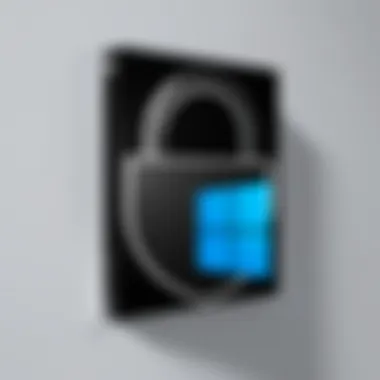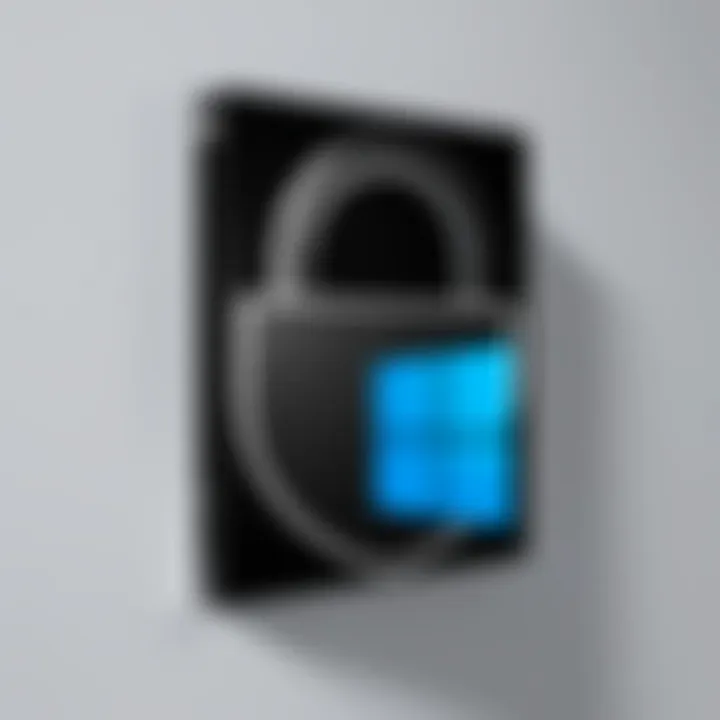Secure Your Data: How to Lock a Folder in Windows 10


Intro
In today's digital landscape, securing sensitive data is essential. Many users store personal or confidential information on their Windows 10 machines without considering the risks involved. Locking folders is a smart way to protect files from unauthorized access. This guide aims to offer a thorough understanding of the various methods available for locking folders in Windows 10, catering to both tech-savvy individuals and everyday users. By the end of this article, readers will gain insights into built-in features and third-party applications suited for enhancing data security.
Product Overview
To begin, let’s explore the key features of folder locking methods available in Windows 10.
Key Features
- Built-in Security Options: Windows 10 provides some options to password protect folders, though they may require specific setups.
- Third-party Applications: There are various applications like Folder Lock and AxCrypt with advanced features for locking folders and encrypting files.
- Ease of Use: Ease of use varies among different tools, but typically, users can secure their data with just a few clicks.
- Compatibility: Most folder-locking software works seamlessly with multiple Windows versions, ensuring users across different setups can utilize them.
Specifications
Folder security options can differ based on whether the user opts for built-in methods or chooses third-party applications. Built-in options often provide a basic level of protection, while dedicated software caters to users needing robust security features such as encryption and more customizable options.
Performance Analysis
When evaluating folder locking methods, speed and efficiency are critical. Users do not want security tools that slow down their system or are cumbersome to use.
Speed and Efficiency
Most built-in methods in Windows 10, when appropriately configured, operate smoothly without major slowdowns. Third-party applications may show varying performance levels. Top-rated ones like Folder Lock have impressive efficiency in encrypting and locking files quickly without noticeable lag during regular use.
Battery Life
For laptop users, maintaining battery life while using data security tools is vital. Generally, well-coded applications should not heavily impact battery performance. However, users should regularly check feedback from other users or forums like Reddit to ensure the chosen method does not cause excessive drain.
Remember: Always choose a folder locking method that balances security with performance. Evaluating user reviews can aid in making an informed decision.
Culmination
In summary, locking folders in Windows 10 is a necessary practice for safeguarding sensitive information. Both built-in options and third-party applications have their pros and cons. Thoroughly considering the user’s needs and the effectiveness of each method will empower individuals to choose the right solution for their data protection needs.
Preamble to Folder Security
In a digital landscape teeming with threats, maintaining folder security has become paramount. The need to secure sensitive data is not just about protecting personal information but also about safeguarding professional files. This article delves into the critical aspects of folder security, particularly within the Windows 10 operating system, to equip users with the necessary tools and understanding to keep their data safe.
When you lock a folder, you are essentially creating a barrier against unauthorized access. This can prevent data theft, identity fraud, or even corporate espionage. The process is simple yet effective, allowing users of varying technical skills to implement security measures with ease.
Why Locking Folders is Important
Locking folders serves multiple functions. Firstly, it protects sensitive information from prying eyes. Without proper security, files can be vulnerable to breaches. Especially for professionals handling confidential data, this becomes a critical concern.
Secondly, locking folders promotes organization and diligence in data management. Users are more likely to keep their digital environment tidy when they implement folder locks, which assists in software like Windows File Explorer.
Moreover, the introduction of security features such as encryption adds another layer of protection. This method encrypts the data within the folders, ensuring that even if someone gains access, the information remains unreadable. Strong folder security is not only beneficial but often necessary in today’s interconnected world.
Common Risks to File Security
Understanding the risks associated with file security can help users appreciate the need for robust measures. Key risks include:
- Unauthorized Access: Unauthorized users might gain access to files due to weak security settings or shared devices.
- Malware and Ransomware: Malicious software can compromise file security, potentially leading to data loss or extortion.
- Data Loss: Accidental deletions, hardware failures or corrupted files can lead to irreplaceable data loss if proper protocols are not in place.
- Insider Threats: Sometimes, the biggest risks come from within the organization or household where individuals with access can misuse their permissions.
Addressing these risks is essential. By implementing strategies for folder security, users can greatly mitigate these threats, ensuring their data remains protected.
Understanding Windows File Management
Understanding the file management system in Windows 10 is crucial for anyone who wants to effectively secure their data. Windows 10 features a structured way of organizing files and folders that enables users to manage their data efficiently. This systematic approach provides options not just for file access, but also for file protection. Knowing how files are organized and the permissions related to them is essential when considering folder security.
In the realm of folder security, being familiar with file management can help users recognize the vulnerabilities in their systems. Those who are tech-savvy need to understand the underlying structures to better implement security measures. This knowledge aids in selecting appropriate methods for locking folders and helps to assess the effectiveness of the chosen strategies. Hence, an understanding of Windows 10 file management is foundational to ensuring data safety.


Overview of Windows File Explorer
Windows File Explorer is the cornerstone of file management in Windows 10. This application provides a graphical user interface for users to navigate through their files and folders effortlessly. The layout is intuitive and allows users to quickly locate, organize, and manage their data. It includes several key features:
- Navigation Pane: Offers quick access to places like Quick Access, This PC, and network locations.
- Search Bar: Enables users to search for files or folders across their drives efficiently.
- Ribbon Interface: Contains multiple options for file management tasks, such as copy, paste, and delete.
Understanding how to utilize Windows File Explorer is necessary for locking folders, as users need to know how to access their targeted files and apply security measures effectively. The more proficient a user is with File Explorer, the easier it becomes to implement data protection.
User Account Control and Permissions
User Account Control (UAC) is a fundamental feature in Windows 10 that contributes to file security by controlling user permissions within the system. It helps in preventing unauthorized changes to the operating system, including modifications to files and settings.
- Permissions: Every file and folder in Windows has specific permissions assigned to it. These determine who can access or modify the content. Using UAC, a user can manage these permissions to restrict access to certain folders.
- Administrative Rights: To lock folders effectively, administrators need to know how to assign user roles and permissions, ensuring sensitive data remains available only to authorized users.
Setting appropriate user permissions ensures that even if a user forgets to lock a folder, unauthorized individuals cannot access the contents without the necessary rights. This proactive approach to security enhances overall data protection.
Understanding these elements will provide a strong foundation for users looking to reinforce their folder security in Windows 10. By mastering the file management capabilities, individuals can deploy strategies that prevent data breaches and maintain privacy.
Built-in Methods to Lock Folders
When it comes to securing sensitive information, utilizing built-in methods in Windows 10 is essential. These options provide users with straightforward and effective ways to lock folders and protect data without the need for third-party software. By employing these methods, users can enhance their data security easily. The benefits of built-in methods include accessibility, integration with the operating system, and generally low resource requirements. Moreover, these solutions often come without the risks associated with installing external tools.
Using Windows BitLocker
Windows BitLocker is a robust feature designed to encrypt entire drives, including specific folders. This built-in encryption tool helps ensure that unauthorized individuals cannot access your files even if they gain physical access to the hard drive. With BitLocker, users can encrypt their data with a password or numeric PIN, adding an extra layer of security.
To use BitLocker:
- Enable BitLocker: Access this feature by right-clicking on the desired drive in File Explorer and selecting ‘Turn on BitLocker’. Follow the prompts to set a password.
- Complete Encryption: Once enabled, the encryption process will begin. The time it takes depends on the size of the drive and amount of data.
BitLocker provides excellent protection because it operates at the disk level. However, it is necessary to backup the recovery key as losing it can lead to data inaccessibility. For a tech-savvy individual, BitLocker is a first-choice method for locking folders and drives securely.
Applying Password Protection via File Properties
Another simple way to lock a folder is through the password protection feature available in Windows File Properties. This method, while not as secure as BitLocker, can be effective for less sensitive information. Essentially, this process allows users to restrict access to a folder by adjusting its permission settings.
To apply password protection:
- Right-click the Folder: Select the folder you want to protect, then choose ‘Properties’ from the context menu.
- Navigate to Security Tab: Click on the ‘Security’ tab to access permission settings.
- Edit Permissions: Click ‘Edit’ to modify who can access the folder. Remove users or groups that should not have access and add those who should.
- Apply Changes: After updating permissions, click ‘OK’ to save your settings.
It’s important to note that this method does not inherently password-protect the folder, but rather restricts access based on user accounts. Therefore, ensuring strong user account security is crucial.
Key Takeaway: Built-in methods like BitLocker and file properties offer fundamental ways to secure folders in Windows 10. They provide practical solutions for enhancing file protection with minimal complexity.
Third-Party Applications for Folder Security
As digital data continues to grow in importance, the need for effective folder security has never been more relevant. While Windows 10 provides built-in methods for data protection, third-party applications can offer additional layers of security and flexibility that may not be available through standard options. This section examines the advantages of using these applications, which can enhance the security of sensitive files, especially for users with specific needs or concerns.
Popular Folder Locking Software
Several software solutions have gained popularity for their ability to secure folders effectively. Among these solutions, Folder Lock, AxCrypt, and Folder Guard stand out because they offer a range of features designed to cater to varying user preferences. Folder Lock is known for its user-friendly interface, while AxCrypt emphasizes strong encryption. In contrast, Folder Guard provides more than just folder locking; it includes the ability to hide files and control access based on user profiles. Choosing the right software depends on individual requirements and the level of protection desired.
Comparative Analysis of Third-Party Tools
When evaluating third-party folder locking tools, several specific elements must be considered, including ease of use, level of security, and cost considerations. Each aspect plays a crucial role in determining which tool is the most effective for securing folders on Windows 10.
Ease of Use
Ease of use is important when selecting folder locking software. A tool that is simple to navigate can significantly minimize the learning curve and reduce frustration. Many users prefer software that offers a clear interface with straightforward instructions. For instance, Folder Lock includes guided setup processes that help users quickly lock their folders without technical assistance. However, some applications might be packed with features that can overwhelm new users, making them less beneficial if the learning curve is steep.
Level of Security


The level of security provided by folder locking tools is a critical component as it determines how effectively sensitive data can be protected. Users should look for solutions that utilize strong encryption methods. Software like AxCrypt employs AES-256 encryption, which is considered highly secure. Meanwhile, other programs may offer standard password protection without robust encryption, posing a risk of unauthorized access. Therefore, evaluating the security features of third-party tools helps ensure that data remains protected from threats.
Cost Considerations
Cost considerations can significantly influence the choice of software for folder security. While many third-party applications offer free versions, these often come with limitations. Premium versions usually provide enhanced features and security, but this can increase overall expenditure. It is important to assess whether the benefits justify the cost. Some tools, like Folder Guard, offer tiered pricing plans, which can be advantageous for users needing specific functionalities without overspending.
In the realm of digital security, choosing the right software is not just about price; the balance between cost and features is paramount for effective data protection.
Step-by-Step Guide to Locking a Folder
Locking a folder is critical for safeguarding sensitive information stored on a computer. Today, a lot of personal and professional data is held on devices running Windows 10. Hence, ensuring privacy by locking folders becomes essential. This section outlines systematic steps to achieve desired security for your data.
Using Windows Built-in Features
Windows 10 offers robust built-in features effective for locking folders. Two prominent methods include BitLocker and setting permissions. Utilizing these tools has distinct advantages, allowing users to manage their data security without additional software.
Step 1: Enable BitLocker
Enabling BitLocker offers a significant contribution towards folder security. This feature encrypts the entire drive, making the data inaccessible to unauthorized users. One key characteristic is its integration within the operating system; it does not require external applications. This makes it a popular choice for users aiming for a reliable, built-in solution.
A unique feature of BitLocker is its use of a Trusted Platform Module (TPM) chip. This ensures that the encryption keys remain secure, tying them to the hardware. An advantage of this approach is enhanced security. However, if you lose access to your TPM or forget your encryption key, recovering your data can prove challenging.
Step 2: Setting Permissions
Setting permissions is another vital way to protect folders. By controlling who has access to specific files, you limit exposure to sensitive information. Its key characteristic lies in the selective granting of access rights. Thus, users can easily specify who can view or edit their folders. Many consider it a beneficial choice since it can be implemented easily without third-party tools.
The unique feature here is the ability to customize access levels. You can set permissions for different users, such as read-only or full access. An advantage includes the flexibility to adapt to changing needs; however, it requires careful management to avoid unintentional access.
Implementing Third-Party Solutions
For those who prefer an additional layer of security, third-party software solutions are available. These tools often provide user-friendly interfaces and enhanced features for managing folder security.
Step 1: Download and Install Software
The initial step involves downloading and installing a trusted folder-locking software. One important aspect is ensuring that the chosen software has positive reviews and a solid reputation. A key characteristic of reliable software includes frequent updates and good customer support, which can significantly enhance user experience.
A unique feature of many third-party applications is the ability to use encryption methods beyond what Windows provides. This advantage offers additional safeguards but might require some learning to use effectively.
Step 2: Create a Secure Folder
Creating a secure folder within the chosen software enables effective data protection. This capability allows users to designate a space where sensitive files reside. Its key characteristic often includes drag-and-drop functionality for easy file management. Many find it a popular choice due to its simplicity and effectiveness.
A unique feature is the seamless integration of password protection with file encryption. This advantage provides dual security, with the potential downside being that if the password is forgotten, recovery might not be simple.
In summation, the methods for locking folders on Windows 10 range from built-in solutions like BitLocker and setting permissions to third-party applications, each with its unique strengths and weaknesses. The choice of method often depends on user requirements and the level of security desired.
Troubleshooting Common Issues
When locking folders in Windows 10, users may encounter various common issues that can complicate the process. This section focuses on the importance of troubleshooting these problems effectively. Understanding how to resolve access issues and conflicts can prevent loss of data or unnecessary frustration.
By being aware of potential problems, users can take proactive measures to secure their files efficiently. Troubleshooting allows individuals to maintain consistent access to their data, ensuring that locking mechanisms do not hinder their workflow. Moreover, familiarity with common issues prepares users for any situations that may arise during the folder locking process.
Recovering Access to Locked Folders
Recovering access to locked folders is essential for maintaining productivity. Suppose a folder becomes inaccessible due to incorrect permissions or software glitches. In that case, users need to know how to regain access without causing damage to their files. Here are steps users can follow to recover access:
- Identify the Locking Method: Determine whether the folder is locked using BitLocker or third-party software.
- Reenter Passwords: If using password protection, simply reenter the correct password to unlock the folder.
- Use Admin Account: Access the folder using an administrator account, which often has broader permissions.
- Utilize Recovery Keys: In case of BitLocker, use the recovery key provided during setup to regain access.
If these methods do not work, consider restoring the folder from a backup, ensuring the data remains safe during recovery efforts. It's important to regularly back up sensitive files to prevent data loss in case of future access issues.
Dealing with Software Conflicts


Software conflicts can arise when third-party folder-locking applications interfere with existing system settings or other software. These conflicts can lead to unexpected behavior, such as a locked folder not appearing or not allowing access even when the correct password is entered. Users can manage these situations with the following strategies:
- Disable Conflicting Software: Temporarily disable any other security software to see if it resolves the issue. Sometimes anti-virus programs may incorrectly flag locking software.
- Update Programs: Keep all software, including Windows 10 itself, updated. Many conflicts arise from outdated systems.
- Check Compatibility: Ensure that the folder-locking software is compatible with your version of Windows 10. Some applications may not function properly if they are designed for earlier versions.
- Reinstall the Application: If issues persist, uninstall and then reinstall the locking software. This can reset the software settings and eliminate conflicts.
Dealing with these challenges effectively allows users to maintain their folder security without sacrificing accessibility. Being prepared to troubleshoot common issues enhances user confidence and ensures a smooth experience with folder locking methods.
Maintaining Folder Security
Maintaining folder security is essential in today’s digital age where data breaches and unauthorized access to information are common threats. Protecting sensitive data requires not only initial security measures but also ongoing vigilance. Continuous adherence to security practices ensures that your information remains safe and intact. This section outlines key practices to enhance folder security, focusing on best practices for data security and understanding backup options.
Best Practices for Data Security
Adopting best practices for data security can significantly reduce the risk of exposure. Two critical practices include regular software updates and periodic security audits. Each serves as a safeguard against vulnerabilities that may arise due to outdated systems or overlooked weaknesses.
Regular Software Updates
Regular software updates are a fundamental aspect of maintaining folder security. When developers release updates, they often fix known security vulnerabilities and bugs. Keeping software up-to-date ensures that your system is equipped with the latest security patches. This proactivity reduces susceptibility to cyber threats like malware or ransomware.
A key characteristic of regular software updates is their frequency. Many software providers offer automatic updates, which is a beneficial feature for users who may overlook manual checks. Regular updates also come with enhancements that improve overall user experience and functionality.
However, a unique feature of these updates is that they may sometimes introduce new bugs or affect compatibility with other software. It’s important for users to review update notes and exercise caution, especially with critical applications. Balancing updates and potential disruptions is key.
Periodic Security Audits
Periodic security audits are essential for assessing the effectiveness of security measures. These audits involve a thorough review of security protocols, user access, and data handling processes. Conducting a security audit helps identify areas of weakness and potential vulnerabilities within the system.
A significant aspect of periodic security audits is their structured approach. By defining a schedule for audits, organizations can ensure that security remains a priority. This consistency aids in recognizing compliance with security standards and regulations.
One unique feature of security audits is the detailed reporting they provide. These reports can highlight incidents, track changes over time, and suggest improvement areas. However, audits can also require substantial resources, both in terms of time and personnel. Organizations must balance the need for thorough audits with the availability of resources.
Understanding Backup Options
Understanding backup options is crucial in the realm of maintaining folder security. Regular backups protect data from loss caused by potential failure or attacks. Options include both cloud storage solutions and physical hard drives. By evaluating these options, users can determine the best method for their data needs.
Cloud storage solutions provide convenience and accessibility. They often come with additional security measures, such as encryption. Conversely, physical drives offer full control over data but require diligent handling to prevent loss or damage. Choosing the right backup option contributes to the overall security strategy, safeguarding sensitive information.
Finale
In this article, we have explored various methods for locking folders in Windows 10, emphasizing the need for robust folder security in today's digital environment. Protecting sensitive data is crucial for both personal and professional users. As cyber threats evolve, so must our strategies for safeguarding information.
The different techniques discussed provide flexibility in selecting a suitable approach based on user needs. Built-in features like BitLocker and permission settings grant users straightforward options without additional software. On the other hand, third-party applications offer advanced functionality tailored for diverse security requirements.
Key Benefits
- Enhanced Security: Locking folders minimizes the risk of unauthorized access. Both built-in and third-party solutions provide layers of protection.
- User Control: Users can decide how to secure their files, adjusting settings to match personal preferences or organizational policies.
- Peace of Mind: Knowing that sensitive information is protected contributes to overall confidence in data management practices.
Considerations
When choosing a method to lock folders, consider the following:
- Ease of Use: Some solutions may be more user-friendly than others. Ensure that the chosen method aligns with your technical comfort level.
- Compatibility: Verify that any third-party software is fully compatible with your version of Windows 10 to avoid conflicts.
- Long-term Implications: Regularly updating security measures, including software, is essential for maintaining lock robustness.
Overall, locking folders in Windows 10 is not just a technical task; it is a vital practice for protecting personal and professional information. By adopting these methods, users can fortify their data against potential threats.
Further Reading and Resources
Understanding how to lock folders in Windows 10 is crucial for securing sensitive information. However, the topic is vast, and many users may have additional questions or seek deeper knowledge. This section emphasizes the importance of further reading and offers valuable resources to reinforce the knowledge acquired throughout the guide.
Resources to Explore
- Official Microsoft Documentation: The Microsoft support website is an essential resource. It provides official guidelines, troubleshooting tips, and updates directly related to Windows 10 features. Review Microsoft’s information on Windows Security for in-depth details.
- Wikipedia Pages on Data Security: Wikipedia offers a broad overview of data security concepts. It is a starting point for understanding basic terms and principles. Visit Data Security for foundational knowledge.
- Tech Forums: Engaging in tech forums like Reddit can provide insights from other users’ experiences and solutions to specific problems. Subreddits such as r/techsupport or r/windows can facilitate discussions with experienced individuals in the community. Check Reddit Tech Support for assistance.
- Educational Articles on Cybersecurity: Websites like Britannica provide articles that explore the implications of data protection and practices for maintaining file security. This can help users understand the broader context of why folder security is essential. Their article on Cybersecurity is worth a read.
Benefits of Further Reading
- Enhanced Understanding: Reading additional material helps solidify the concepts covered in this article. It expands one’s knowledge about security measures, methodologies, and potential risks.
- Stay Updated: Technology and security practices evolve rapidly. Keeping abreast of the latest trends and updates is essential for anyone serious about safeguarding data.
- Community Insights: Interacting with others seeking to secure their data can yield practical advice not found in manuals or official documents. Sharing experiences enrich learning.
- Diverse Perspectives: Different authors and experts will have varying viewpoints on security practices. Exploring a range of opinions can enable informed decision-making when choosing methods.
The knowledge acquired from further reading directly complements practical application, ensuring effective folder security.
In summary, while this guide offers foundational steps and methods to lock folders in Windows 10, delving deeper through these suggested resources can equip users with robust strategies to enhance their data security. Engaging with a variety of materials not only informs but also empowers users to make better decisions in their digital lives.



